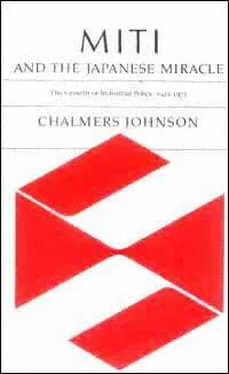Chalmers Johnson - MITI and the Japanese miracle
Здесь есть возможность читать онлайн «Chalmers Johnson - MITI and the Japanese miracle» весь текст электронной книги совершенно бесплатно (целиком полную версию без сокращений). В некоторых случаях можно слушать аудио, скачать через торрент в формате fb2 и присутствует краткое содержание. Год выпуска: 2007, Издательство: Stanford University Press, Жанр: Старинная литература, на английском языке. Описание произведения, (предисловие) а так же отзывы посетителей доступны на портале библиотеки ЛибКат.
- Название:MITI and the Japanese miracle
- Автор:
- Издательство:Stanford University Press
- Жанр:
- Год:2007
- ISBN:нет данных
- Рейтинг книги:3 / 5. Голосов: 1
-
Избранное:Добавить в избранное
- Отзывы:
-
Ваша оценка:
- 60
- 1
- 2
- 3
- 4
- 5
MITI and the Japanese miracle: краткое содержание, описание и аннотация
Предлагаем к чтению аннотацию, описание, краткое содержание или предисловие (зависит от того, что написал сам автор книги «MITI and the Japanese miracle»). Если вы не нашли необходимую информацию о книге — напишите в комментариях, мы постараемся отыскать её.
MITI and the Japanese miracle — читать онлайн бесплатно полную книгу (весь текст) целиком
Ниже представлен текст книги, разбитый по страницам. Система сохранения места последней прочитанной страницы, позволяет с удобством читать онлайн бесплатно книгу «MITI and the Japanese miracle», без необходимости каждый раз заново искать на чём Вы остановились. Поставьте закладку, и сможете в любой момент перейти на страницу, на которой закончили чтение.
Интервал:
Закладка:
Page 200
countries also to devalue their currencies. Japan, which had just pegged its own currency at ¥360 to $1, suddenly found that its products were overpriced in its principal export markets. During the winter of 194950 the Japanese people faced some of the harshest economic conditions they had seen since the war ended, and the threat of revolution came perilously close.
3
On June 25, 1950, warfare erupted on the Korean peninsula, and the United States intervened. This development ended the "stabilization panic" quantitatively, if not qualitatively. In addition to the American foreign aid that had sustained the Japanese economy since stabilization began, the United States now began to place extensive orders with Japanese firms for ammunition, trucks, uniforms, communications equipment, and other products needed for the war effort. The Americans also started to buy fertilizers and consumer goods destined for South and Southeast Asian noncommunist countries as part of the American foreign aid effort. For example, between July 1950 and February 1951 the U.S. armed forces and the U.S. Economic Cooperation Administration placed orders with Japanese firms for some 7,079 trucks worth nearly $13 million; this was the key to the revival of the Japanese automotive industry.
4
The Enterprises Bureau of MITI supervised these "special procurements" (
tokuju
) to ensure that the foreign exchange thus gained was used for investment in basic industries. For a while the "special procurements boom," as it was called, provided a false sense of euphoria and a feeling that the hard times were over. Special procurements plus the expenditures of U.S. troops and their dependents constituted 37 percent of all foreign exchange receipts in 195253, and they still contributed 11 percent in 195960.
5
This windfall, however, created major internal financial difficulties. Japanese firms could not obtain investment capital fast enough to retool to meet the orders that the Americans were placing, and their working capital was insufficient to keep them in business if even a few of their contracts involved delays in payment of six months or more. The Japanese economic bureaucrats debated among themselves about what emergency measures to take to rectify this situation, and the outcome of this debate had a profound significance for the economy of later years and for governmental economic policy. It led to the two-tiered structure of government-guaranteed "city bank" overloaning and newly created government-owned "banks of last resort." These latter institutions, particularly the Japan Development Bank (Nihon Kaihatsu Ginko*, abbreviated Kaigin), came to possessand still retain todaytremendous indicative powers over the whole economy as a result of their decisions to make or refuse "policy loans."
Page 201
TABLE
14
Governors of the Bank of Japan, 19451975
Governor and tenure
Background
Shibusawa Keizo *, 3/4410/45
Yokohama Specie Bank; Dai Ichi Bank.
Araki Eikichi, 10/456/46
Bank of Japan; purged; depurged, 1950.
Ichimada Naoto, 6/4612/54

Bank of Japan; later minister of finance in the Hatoyama and Kishi cabinets.
Araki Eikichi, 12/5411/56
See above.
Yamagiwa Masamichi, 11/5612/64

Ex-vice-minister of finance; Export-Import Bank.
Usami Makoto, 12/6412/69
Mitsubishi Bank.
Sasaki Tadashi, 12/6912/74
Bank of Japan.
Morinaga Teiichiro, 12/7412/79

Ex-vice-minister of finance; Export-Import Bank.
The two great antagonists in this industrial finance debate were Ikeda Hayato (18991965), former vice-minister of finance and minister of finance in the third Yoshida cabinet (February 1949 to October 1952), and Ichimada Naoto (b. 1893), governor of the Bank of Japan from June 1946 to December 1954.
*
Their conflict was based as much on political and bureaucratic differences as it was on genuine differences over policy. As it turned out, Ikeda emerged victorious and his ministry asserted its dominance over the Bank of Japan (particularly after November 1956, when for the first time in 29 years the ministry named one of its own officials governor of the bank; see Table 14). But Ichimada made his own important contribution to Japan's economic future, despite the bad press he has received from MITI officials because of his opposition to heavy industrialization. During the Dodge Line and Korean War periods, Ikeda and Ichimada each invented one tier of the two-tiered Japanese system of industrial financinga wonderful instrument on which MITI would become a virtuoso player.
Ikeda was not precisely an inflationist in the mold of Ishibashi Tan-


*
In order to follow Ikeda's activities, the following dates should be kept in mind. While serving as minister of finance in the third Yoshida cabinet, Ikeda also held the concurrent post of minister of MITI from February to April, 1950. Yoshida then named him MITI minister in his fourth cabinet, but he was forced to resign after only a month in office (Oct.Nov. 1952) because of his "slip of the tongue" in the Diet (discussed below). Between 1952 and 1956 he held various Liberal Party posts, including that of secretary-general. From December 1956 to July 1957 he returned to the cabinet as minister of finance. His last cabinet post (June 1959 to July 1960) before becoming prime minister was again as minister of MITI. References to Ikeda's "own" ministry of course refer to the Ministry of Finance, in which he served as a bureaucrat from 1925 to 1948.
Page 202
zan, but he was also not a typical fiscal conservative of the Finance Ministry. During the late 1950's he fought as hard against his own ministry to get his ideas of "positive finance" accepted as he had earlier against the deflationists of the central bank.
6
He believed that the government was the only available source of capital for industry, and he was a supporter of the activities of such governmental financial institutions as the Industrial Bank before and during the war and the RFB during the occupation. Although his name is associated with so-called low-posture politics because, as prime minister after Kishi and in the wake of the 1960 security treaty riots, he shifted the focus of government from politics to economics, he was very outspoken in internal debate.
7
On November 27, 1952, in a famous incident, Ikeda was forced to resign as MITI minister and accept a temporary setback in his political career because he had said too candidly in the Diet, "It makes no difference to me if five or ten small businessmen are forced to commit suicide" as a result of the heavy industrialization efforts.
8
Ikeda must be recorded as the single most important individual architect of the Japanese economic miracle.
Ichimada held almost directly contrary financial views. He had served in Germany before the war and was personally acquainted with the German inflation, so he strongly agreed with SCAP's opposition to Ishibashi's inflationary policies of 1947. Throughout the occupation, with most senior zaibatsu executives purged and the commercial banks virtually the only institutions left unscathed, Ichimada wielded enormous powers over the banks and their borrowers through his decisions on how much the Bank of Japan would let them borrow. After Dodge launched his deflation and the "stabilization panic" hit, Ichimadanow known to the press as "Pope Ichimada"came to exercise life-or-death powers over businesses. Partly as a result of his German experiences and partly because most of the inflationists were concentrated in the Finance Ministry, Ichimada came to stand for a deflationary, balanced-budget fiscal policy and for a mildly expansionist monetary policy. During the capital shortage Ichimada upped the tempo of government loans to city banks (the twelve national banks to which the Bank of Japan extends loan privileges), who in turn distributed the funds to the industrialists who were clamoring for money to expand their facilities. He never went as fast as Ikeda and MITI would have liked, but he started the process of central bank "overloaning" that led to the nexus between the city banks and industry that persists to the present day. In the process he virtually insured that SCAP's proposal for a capital market for industrial financing (a stock exchange) would remain stillborn for at least twenty years.
Читать дальшеИнтервал:
Закладка:
Похожие книги на «MITI and the Japanese miracle»
Представляем Вашему вниманию похожие книги на «MITI and the Japanese miracle» списком для выбора. Мы отобрали схожую по названию и смыслу литературу в надежде предоставить читателям больше вариантов отыскать новые, интересные, ещё непрочитанные произведения.
Обсуждение, отзывы о книге «MITI and the Japanese miracle» и просто собственные мнения читателей. Оставьте ваши комментарии, напишите, что Вы думаете о произведении, его смысле или главных героях. Укажите что конкретно понравилось, а что нет, и почему Вы так считаете.












